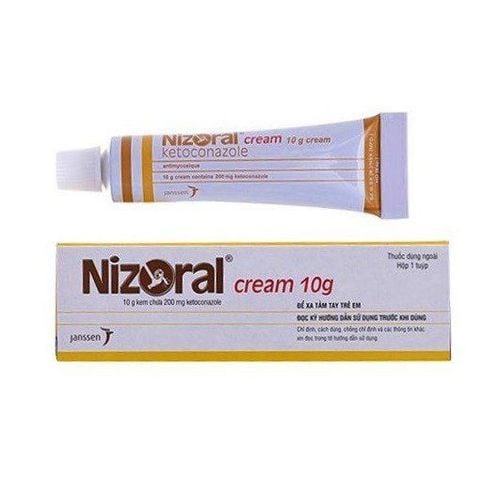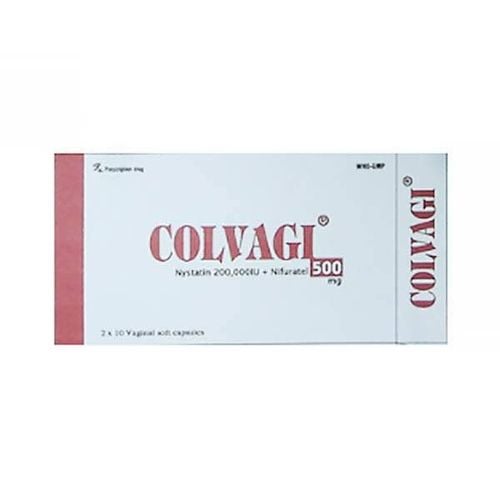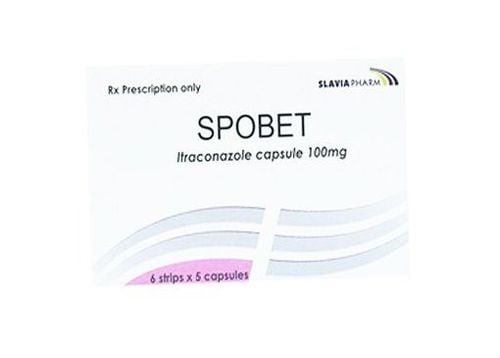This is an automatically translated article.
Itraconazole is a medicine used in the treatment of certain fungal infections. So what is the use of Itraconazole and how is it used?
1. Uses of the drug Itraconazole
Itraconazole has the main active ingredient Itraconazole, which is a synthetic triazole antifungal agent. The drug works better than ketoconazole against some fungi, especially against Aspergillus spp.
Itraconazole is prepared in the following drug forms and strengths:
100 mg capsules. Oral solution 10 mg/ml (150 ml). Solution for infusion 10 mg/ml. Itraconazole is indicated in the following cases:
Candida in the mouth and throat. Vaginal and vaginal candidiasis. Lang Ben . Dermatophytosis sensitive to Itraconazole (such as fungal diseases caused by Microsporum spp., Trichophyton spp., Epidermophyton floccosum): Tinea pedis, dermatomyositis, inguinal skin, interstitial skin. Toenail fungus (tinea unguium). Pulmonary and extrapulmonary blastomyces. Histoplasmosis includes both chronic lung disease and sporadic, non-meningococcal histoplasmosis. Pulmonary and extrapulmonary aspergillosis in patients intolerant to or resistant to amphotericin B. Use in maintenance therapy in patients with AIDS to prevent recurrent latent fungal infections. Prophylaxis of fungal infections during prolonged neutropenia, for which conventional treatments are ineffective. On the other hand, Itraconazole is contraindicated in the following cases:
People with hypersensitivity to any ingredient of the drug. Do not use concomitantly with some antiarrhythmic drugs, lipid-lowering drugs of the statin group. The patient is being treated with terfenadine, cisapride, astemizol, oral triazolam, oral midazolam. Women who are pregnant or planning to become pregnant.
2. Dosage and how to use Itraconazole
2.1. How to take Itraconazole Capsules and oral solution of Itraconazole cannot be used interchangeably. The capsule form must be taken immediately after a meal and must be swallowed.
Oral solution of Itraconazole has been shown to be effective only against candidiasis of the mouth and esophagus and must be taken on an empty stomach; When taking, must gargle the solution in the mouth for a few seconds before swallowing.
2.2. Dosage Dosage Itraconazole drug should follow the doctor's prescription, the reference dose is as follows:
2.2.1. Capsule form Short-term treatment:
Vaginal candidiasis: Use a dose of 200mg orally twice a day, only for 1 day, or use a dose of 200mg orally once a day, for 3 days. Ringworm: Use a dose of 200mg, orally once a day, for 7 days. Dermatophytosis: Use a dose of 100mg orally once a day for 15 days. If the area is highly keratinized, an additional 15 days of treatment with a dose of 100 mg per day is required. Oral - pharyngeal candidiasis: Use a dose of 100mg orally once a day for 15 days. For patients with AIDS or neutropenia: Use a dose of 200mg orally once a day for 15 days. Long-term treatment (systemic fungal infections), the duration of treatment depends on the clinical and fungal response:
Onychomycosis : Use a dose of 200mg orally once a day for 3 months. Aspergillus: Use a dose of 200mg orally once a day for 2-5 months. The dose can be increased if the fungus spreads: Use a dose of 200mg/time, 2 times/day. Candidiasis: Use a dose of 100-200mg orally once a day, for 3 weeks - 7 months. The dose can be increased to 200mg/time, twice a day, if the disease is widespread. Cryptococcus (non-meningitis): Use a dose of 200mg/time, 1 time/day, within 2 months - 1 year. Meningitis caused by Cryptococcus: Use a dose of 200mg / time, orally 2 times / day. The maintenance dose is 200mg, once a day. Histoplasmosis and Blastomyces: Use a dose of 200mg/time, orally 1-2 times/day, within 8 months. Maintenance treatment in AIDS: Use a dose of 200mg/time, 1 time/day. Prophylaxis in neutropenia: Use a dose of 200mg / time, 1 time / day. 2.2.2. Oral solution form Oral candidiasis: Use a dose of 200mg (20ml), 1 time / day, for 1-2 weeks. Esophageal candidiasis: Use a dose of 100mg (10ml), once a day, for a minimum of 3 weeks. After symptoms subside, maintenance therapy should be continued for 2 weeks.
3. Itraconazole side effects
Here are some side effects that users may experience during the use of Itraconazole 100mg:
Common side effects of Itraconazole include: Dizziness, Headache, Nausea, Abdominal pain, Constipation , Digestive disorders. Uncommon side effects of Itraconazole include: Pruritus, Rash, Urticaria, Angioedema, Stevens-Johnson syndrome Rare side effects of Itraconazole include: Peripheral neuropathy. Side effects of undetermined frequency of Itraconazole include: dyspepsia, dyspnea, tachypnea.
4. Interaction of Itraconazole with other drugs
Contraindicated combination of Itraconazole 100mg with the following drugs Terfenadine, Astemizole, Cisapride because it can increase the concentration of these drugs in the blood plasma, leading to fatal arrhythmias. Oral Diazepam, Midazolam, Triazolam are contraindicated for use with Itraconazole. Itraconazole 100mg taken with warfarin will increase the anticoagulant effect of warfarin. Caution should be exercised when itraconazole is co-administered with calcium channel blockers because it may cause edema and tinnitus. Itraconazole also inhibits the metabolism of calcium blockers, leading to an increased risk of congestive heart failure. If Itraconazole is used with cholesterol-lowering drugs of the HMG - CoA reductase inhibitor class (such as lovastatin, atorvastatin, simvastatin, pravastatin, etc.), blood levels of these drugs may be increased, leading to an increased risk of inflammation. muscle or muscle disease. When using the drug Itraconazole with digoxin increases the concentration of digoxin in the blood plasma. When using Itraconazole 100mg with oral antidiabetic drugs causes severe hypoglycemia. Co-administration of Itraconazole 100mg with antacids, or H2 antagonists (eg, cimetidine, ranitidine) or omeprazole, sucralfate, will cause the bioavailability of Itraconazole to be significantly reduced, causing the anti-fungal effect to be lost. Co-administration of Itraconazole with CYP inducers (e.g. rifampicin, isoniazid, phenobarbital, phenytoin) reduces plasma concentrations of Itraconazole.
Please dial HOTLINE for more information or register for an appointment HERE. Download MyVinmec app to make appointments faster and to manage your bookings easily.













